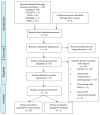Virtual Reality-Based Therapy Reduces the Disabling Impact of Fibromyalgia Syndrome in Women: Systematic Review with Meta-Analysis of Randomized Controlled Trials
- PMID: 34834518
- PMCID: PMC8621064
- DOI: 10.3390/jpm11111167
Virtual Reality-Based Therapy Reduces the Disabling Impact of Fibromyalgia Syndrome in Women: Systematic Review with Meta-Analysis of Randomized Controlled Trials
Abstract
Background: Virtual reality-based therapy (VRBT) is a novel therapeutic approach to be used in women with fibromyalgia syndrome (FMS). The aim of our study is to assess the effect of VRBT to reduce the impact of FMS in outcomes such as pain, dynamic balance, aerobic capacity, fatigue, quality of life (QoL), anxiety and depression.
Methods: Systematic review with meta-analysis was conducted from a bibliographic search in PubMed, Scopus, PEDro, Web of Science and CINAHL until April 2021 in accordance with PRISMA guidelines. We included randomized controlled trials (RCTs) that compare VRBT versus others to assess the mentioned outcomes in women with FMS. Effect size was calculated with standardized mean difference (SMD) and its 95% confidence interval (95% CI).
Results: Eleven RCTs involving 535 women with FMS were included. Using the PEDro scale, the mean methodological quality of the included studies was moderate (6.63 ± 0.51). Our findings showed an effect of VRBT on the impact of FMS (SMD -0.62, 95% CI -0.93 to -0.31); pain (SMD -0.45, 95% CI -0.69 to -0.21); dynamic balance (SMD -0.76, 95% CI -1.12 to -0.39); aerobic capacity (SMD 0.32, 95% CI 0.004 to 0.63); fatigue (SMD -0.58, 95% CI -1.02 to -0.14); QoL (SMD 0.55, 95% CI 0.3 to 0.81); anxiety (SMD -0.47, 95% CI -0.91 to -0.03) and depression (SMD -0.46, 95% CI -0.76 to -0.16).
Conclusions: VRBT is an effective therapy that reduces the impact of FMS, pain, fatigue, anxiety and depression and increases dynamic balance, aerobic capacity and quality of life in women with FMS. In addition, VRBT in combination with CTBTE showed a large effect in reducing the impact of FMS and fatigue and increasing QoL in these women.
Keywords: fatigue; fibromyalgia; meta-analysis; pain; physiotherapy; quality of life; virtual reality.
Conflict of interest statement
The authors declare no conflict of interest.
Figures









Similar articles
-
Virtual reality-based therapy after anterior cruciate ligament injury effectively reduces pain and improves knee function, movement patterns, and dynamic balance: A systematic review and meta-analysis.Knee Surg Sports Traumatol Arthrosc. 2025 May;33(5):1736-1753. doi: 10.1002/ksa.12477. Epub 2024 Sep 20. Knee Surg Sports Traumatol Arthrosc. 2025. PMID: 39302094 Free PMC article.
-
Optimal dose and type of exercise to reduce pain, anxiety and increase quality of life in patients with fibromyalgia. A systematic review with meta-analysis.Front Physiol. 2023 Apr 12;14:1170621. doi: 10.3389/fphys.2023.1170621. eCollection 2023. Front Physiol. 2023. PMID: 37123268 Free PMC article.
-
Digital and Interactive Health Interventions Minimize the Physical and Psychological Impact of Breast Cancer, Increasing Women's Quality of Life: A Systematic Review and Meta-Analysis.Cancers (Basel). 2022 Aug 26;14(17):4133. doi: 10.3390/cancers14174133. Cancers (Basel). 2022. PMID: 36077670 Free PMC article. Review.
-
Virtual Reality-Based Therapy Can Enhance Balance and Muscular Endurance in Children and Adolescents with Down Syndrome: A Systematic Review with a Meta-Analysis.Bioengineering (Basel). 2024 Nov 4;11(11):1112. doi: 10.3390/bioengineering11111112. Bioengineering (Basel). 2024. PMID: 39593772 Free PMC article. Review.
-
Early rehabilitation using virtual reality-based therapy can enhance hip function and self-perception of improvement following total hip arthroplasty: A systematic review and meta-analysis.Geriatr Nurs. 2024 Nov-Dec;60:593-601. doi: 10.1016/j.gerinurse.2024.10.020. Epub 2024 Oct 29. Geriatr Nurs. 2024. PMID: 39489945
Cited by
-
Feasibility of attention-based virtual reality interventions in fibromyalgia syndrome: comparing systems, virtual environments and activities.Br J Pain. 2025 Jan 4:20494637241310696. doi: 10.1177/20494637241310696. Online ahead of print. Br J Pain. 2025. PMID: 39763629 Free PMC article.
-
Technological Features of Immersive Virtual Reality Systems for Upper Limb Stroke Rehabilitation: A Systematic Review.Sensors (Basel). 2024 May 31;24(11):3546. doi: 10.3390/s24113546. Sensors (Basel). 2024. PMID: 38894337 Free PMC article.
-
Effectiveness and user experience of a virtual reality intervention in a cohort of patients with chronic musculoskeletal pain syndromes.PLOS Digit Health. 2025 Mar 31;4(3):e0000788. doi: 10.1371/journal.pdig.0000788. eCollection 2025 Mar. PLOS Digit Health. 2025. PMID: 40163491 Free PMC article.
-
The Efficacy of Virtual Reality on the Rehabilitation of Musculoskeletal Diseases: Umbrella Review.J Med Internet Res. 2025 Apr 25;27:e64576. doi: 10.2196/64576. J Med Internet Res. 2025. PMID: 40279163 Free PMC article.
-
Non-Immersive Virtual Reality-Based Therapy Applied in Cardiac Rehabilitation: A Systematic Review with Meta-Analysis.Sensors (Basel). 2024 Jan 30;24(3):903. doi: 10.3390/s24030903. Sensors (Basel). 2024. PMID: 38339621 Free PMC article.
References
-
- Wolfe F., Clauw D.J., Fitzcharles M.-A., Goldenberg D.L., Katz R.S., Mease P., Russell A.S., Russell I.J., Winfield J.B., Yunus M.B. The American College of Rheumatology Preliminary Diagnostic Criteria for Fibromyalgia and Measurement of Symptom Severity. Arthritis Rheum. 2010;62:600–610. doi: 10.1002/acr.20140. - DOI - PubMed
-
- Lomas-Vega R., Rodríguez-Almagro D., Peinado-Rubia A.B., Zagalaz-Anula N., Molina F., Obrero-Gaitán E., Ibáñez-Vera A.J., Osuna-Pérez M.C. Joint Assessment of Equilibrium and Neuromotor Function: A Validation Study in Patients with Fibromyalgia. Diagnostics. 2020;10:1057. doi: 10.3390/diagnostics10121057. - DOI - PMC - PubMed
-
- Montoro C.I., del Paso G.A.R., Duschek S. Alexithymia in fibromyalgia syndrome. Pers. Individ. Differ. 2016;102:170–179. doi: 10.1016/j.paid.2016.06.072. - DOI
-
- Peinado-Rubia A., Osuna-Pérez M.C., Rodríguez-Almagro D., Zagalaz-Anula N., López-Ruiz M.C., Lomas-Vega R. Impaired Balance in Patients with Fibromyalgia Syndrome: Predictors of the Impact of This Disorder and Balance Confidence. Int. J. Environ. Res. Public Health. 2020;17:3160. doi: 10.3390/ijerph17093160. - DOI - PMC - PubMed
Publication types
LinkOut - more resources
Full Text Sources
Miscellaneous

